World Nutrition
Volume 3, Number 12, December 2012
Journal of the World Public Health Nutrition Association
Published monthly at www.wphna.org
The Association is an affiliated body of the International Union of Nutritional Sciences For membership and for other contributions, news, columns and services, go to: www.wphna.org
Commentary. The Food System. Ultra-processing
The big issue for nutrition,
disease, health, well-being

Carlos Monteiro, Geoffrey Cannon
Renata Bertazzi Levy, Rafael Claro, Jean-Claude Moubarac,
with Ana Paula Martins, Maria Laura Louzada, Larissa Baraldi,
Daniela Canella, at the Centre for Epidemiological Studies in Health
and Nutrition, School of Public Health, University of São Paulo, Brazil
Biographies posted at www.wphna.org
Email: carlosam@usp.br
Access pdf of 2009 Public Health Nutrition paper here
Access pdf of 2010 American Journal of Public Health paper here
Access pdf of November 2010 WN editorial here
Access pdf of 2010 Cadernos de Saúde Pública paper here
Access pdf of 2011 Public Health Nutrition paper here
Access pdf of 2012 PLoS Medicine paper here
Access pdf of June 2012 WN editorial here
Access pdf of June 2012 WN commentary here
Access pdf of September 2012 WN commentary here
Access pdf of this month's editorial here
Access pdf of this commentary here
THE FOOD
SYSTEM
The big issue for nutrition

A new classification of foods, with its
implications for assessment of diets,
promotion of good health and well-being,
and prevention and control of obesity and
related chronic non-communicable diseases
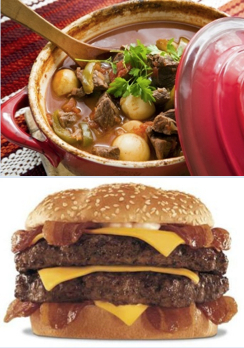
Food processing is now the main shaping force of the global food system, and the main determinant of the nature of diets and related states of health and well-being.
To reveal this, we have here created a new classification of foods. This gives primary importance to the nature, extent and purpose of food processing.
Group 1 is of foods
Group 2 is of culinary ingredients
Together, these are made into meals, as symbolised by the cooking pot
Group 3 is of food products
These are made ready-to-consume, as symbolised by the cheese-bacon-burger
Introduction
Note
This work is now being done in conjunction with the World Public Health Nutrition Association, as a project in support of and supported by the Association. The views expressed in our work here and in other publications should not be taken to be
those of the Association.
Our general theory is that the global food system, and specifically its increasing domination by processed food products as specified and defined here, is the big issue for nutrition, disease, health and well-being. We begin here by explaining the history and development of the theory and its context, and our findings and thinking so far. We also outline implications for assessment of dietary patterns, development of dietary guidelines, promotion of good health and well-being, and prevention and control of obesity and related chronic non-communicable diseases.
It is evident, we believe, that the current conceptual framework of nutrition, which places it solely or mainly within the biological sciences, does not adequately respond to the circumstances of our time. Undernutrition, food insecurity and hunger persist in many parts of the world, even within high-income countries, at unacceptable and even scandalous levels. But what is now the pandemic of overweight and obesity, and of other related chronic non-communicable diseases such as diabetes, is out of control. We believe that this global public health crisis will remain uncontrolled until a new and more relevant and appropriate conceptual framework is developed, accepted, and applied. Our purpose here is to develop this new way of thinking, which from our experience and in our judgement so far, is the best fit with the facts.
Three phases of nutrition science
As from its beginnings in the early 19th century, with the identification of protein, carbohydrate and fat as separate entities, the modern science of nutrition has mainly been concerned with nutrients and then later with foods, and their effect on growth and physical health. The theory and practice of the science has so far gone through three phases, in response to changing circumstances (1).
In the first phase, beginning in the 19th century, with the identification and isolation of macronutrients and especially protein, nutrition scientists paid special attention to growth and health most of all in early life. In the second phase, corresponding to the discovery of the properties of vitamins and other micronutrients, and to awareness of various diseases as deficiency states, a new main focus was and still remains prevention and control of nutrient deficiency diseases.
The third phase, beginning in the second half of the last century and up to now, has corresponded to increasingly powerful methods of nutritional epidemiology and to awareness of various nutrients and foods as modifiers of the risk at first of cardiovascular disease, which became explosively epidemic in many countries roughly beginning in the 1950s. In this period necessary priority has also been given to successive attempts to prevent and control other diet-related chronic diseases and obesity (2,3).
The science of nutrition has developed phenomenally, with among many examples the identification of essential fatty acids, agreement on the relevance of dietary fibre, acceptance of the importance of bioactive compounds not seen as nutrients, profound new insights into the metabolism of dietary energy and nutrients, and understanding of genotype and phenotype expression in response to endogenous and exogenous modifiers of disease risk.
The prevailing concern throughout, has however remained the impact of nutrients and foods, now with increasing attention to dietary patterns, on growth, health, and the prevention and control of physical disease. Correspondingly, the ways in which foods are classified with nutrition and health in mind, while refined and modified, have not fundamentally changed since the early 20th century. We believe that a fundamental change is now needed.
The fourth phase
This is why. What has now emerged is a new and global food system that largely determines the food supplies in most high-income and now also many lower-income countries. This therefore also largely determines dietary patterns, made up from the types of foods and products that populations purchase and consume. The circumstances to which nutrition science now needs to respond, are radically and systematically different from those of previous centuries.
In and since the 1980s, patterns of food production and consumption, and of patterns of diet and disease, have been changing extremely rapidly. The impact is most dramatic in countries such China, India, Russia, South Africa, and Mexico, in Brazil where we work, and now in most middle- and even low-income countries. This is wholly new.
Making sense of circumstances
In this context, members of the team, who work at the Centre for Epidemiological Studies in Health and Nutrition at the School of Public Health, University of São Paulo (USP), Brazil, began in the 1990s to make a remarkable and disturbing observation. The emergence and rise of overweight and obesity and some related chronic non-communicable diseases as major public health problems in Brazil, notably since the 1980s, often did not correspond to changes in consumption of specific nutrients or foods. Correlation does not prove causation, but lack of correlation is a warning sign that assumptions about causation may well be shaky or even mistaken.
Working with the meticulous household food purchase surveys undertaken in Brazil since the 1970s, the USP team observed a different pattern (4-5). The rapid rise in overweight and obesity since that time was not well correlated for example with any rise in fat or sugar as such. Instead, a clear correlation was observed with consumption of types of processed food and drink products, such as sugared soft drinks, cookies (biscuits), and certain types of fatty meat products such as sausages and burgers often consumed in the form of snack-type meals together with sugared products.
These products, while superficially different, have properties in common. As well as being pre-prepared and ready-to-consume, overall they are energy-dense, fatty, sugary or salty, and formulated to be hyper-palatable. This suggested – to continue with the two examples – that the significance of fat and sugar is not these substances in isolation, but rather as contained and combined in certain types of food product. In turn this suggested that the focus should not be on nutrients as such, or foods as such, but on types of product that should be classified together as one group.
The USP team members therefore developed a conceptual framework demonstrated in the form of a new classification of food. This was initially published in Public Health Nutrition (6), then in a leading Brazilian journal (7), and then two years ago in this journal (8), with other commentaries (as examples, 9-18) two of which, published recently (17-18), lead up to this updated, adjusted and expanded commentary.
Following many presentations at international conferences, and much discussion with colleagues all over the world, especially in the last two years, this commentary summarises our current position. It remains work in progress. We are in process of challenging our thesis with recent research findings, in Brazil (19-21) and in other countries (22). We invite colleagues in other research centres working independently from us, to use our classification as set out in the text that follows, and to see if their results support or refute our general thesis.
Ultra-processing
As said above, our specific thesis within our general theory, is that the principal dietary driver of pandemic overweight and obesity, and of related chronic non-communicable diseases, is what we identify as ultra-processed products. While edible and usually very palatable, these are not real foods. They are fundamentally different from foods that have been processed, however intensively, in ways that modify or even transform the original unprocessed food.
Ultra-processed products are not made from foods. They are made from ingredients. Some of these are derived from foods, such as oils, fats, flours, starches, and sugar, but many are obtained by the further processing of food constituents, such as hydrogenated oils, hydrolysed proteins, starch-modified sugars, and extruded or otherwise processed remnants of meat. Numerically, the great majority of the ingredients of ultra-processed products are additives of a variety of types, which include among others, preservatives; stabilisers, emulsifiers, solvents, binders, bulkers; sweeteners, sensory enhancers, flavours, and colours. The function of many of these is to make the product look, smell, feel and taste like food. Bulk may come from air or water. Synthetic micronutrients may be added to 'fortify' the products.
These products taken together began to dominate the food supplies of high-income countries in the global North such as the US, Canada, and the UK in the second half of the last century. The rates of their production and consumption accelerated as from the 1980s, as did rates of obesity including among children. This pattern more recently has been and is being repeated in countries of the global South. The food supplies of countries such as Mexico and Chile are already practically saturated with ultra-processed products. Rates of overweight and obesity in these countries are already much the same as those of high-income countries in which for some time have been saturated with ultra-processed products. Trends evident in Asia, Africa, Latin America, and other regions, are all in the same direction.
Our first publications
Following initial publications (6,7) our first major commentary in this journal, with an accompanying editorial (8,9) began by stating: 'The most important factor now, when considering food, nutrition and public health, is not nutrients, and is not foods, so much as what is done to foodstuffs and the nutrients originally contained in them, before they are purchased and consumed'. It continued: 'That is to say, the issue is food processing – or, to be more precise, the nature, extent and purpose of processing, and what happens to food and to us as a result of processing. Specifically, the big public health issue is "ultra-processing", as defined here'.
We were not saying then, nor are we saying now, that nutrients and foods are unimportant. That would be absurd. What we were stating, and affirm here, is that the central issue that confronts everybody now, is the form in which foods and food products are produced and consumed. This indicates the relevance of the social, cultural, economic, political, environmental and other broad dimensions of nutrition, as well as its behavioural and biological dimensions, and also the evolutionary and historical aspects of food and nutrition.
Seeing things as they are
As indicated above, we now go further than we did two years ago. The really big issue is not just ultra-processing. It is the whole context in which people throughout the world are consuming more and more ultra-processed products. This includes the rise since the 1980s of gigantic transnational corporations whose colossal sales and profits depend on, and market value and share price derive from, aggressively advertised and marketed intrinsically unhealthy branded ultra-processed products (10,13-16,18, 23-25). Any view focused on the biological nature of nutrition cannot perceive this big picture.
When modern nutrition science was first devised, the diets of most populations were usually in the form of meals and dishes mostly made from a combination of foods and culinary ingredients. This ceased to be so in high-income industrialised countries such as the US and the UK in the second half of the 20th century. Now in lower-income countries, meals and long-established food systems are rapidly being displaced by energy-dense fatty, sugary or salty ready-to-consume food products, often in snack or drink form (13, 18, 23-25). These countries include those throughout Asia, Africa, the Mediterranean region, the former USSR, the Arab world, and Latin America.
In these circumstances, it is apparent that all classifications of food into groups such as vegetables and fruits, or grains (cereals), or meat, poultry and fish, have limited value and meaning. When these include in the same group unprocessed or minimally processed foods together with ultra-processed products (such as when 'cereals and cereal products' includes whole grains and also sugared breakfast cereals and biscuits, and when 'meat and meat products' includes fresh chicken and 'nuggets'), they are misleading and counter-productive. Such classifications certainly do not appear to be an effective way to prevent or control overweight and obesity, and related diseases. We believe that this is because they do not pay adequate attention to the nature, extent and purpose of processing, and do not make clear distinctions between healthy foods that are unprocessed or minimally processed, and products whose general effect is harmful to health.
Our new classification
By contrast, our new classification, specified below, focuses on processing. Thus, our 'group 1', of unprocessed and minimally processed foods, includes all types of such food, whether of plant or animal origin. Processed culinary ingredients, designed to be combined with foods to make meals and dishes, are our group 2. All products formulated principally or wholly from ingredients, with typically little or no fresh food, we classify within our 'group 3' as ultra-processed products.
The classification
Here follows the new classification of foods, with its implications for the promotion of good health and of well-being, and for the understanding, prevention and control of the worldwide epidemic of obesity and related chronic non-communicable diseases.
Until now, classifications have grouped foods according to their nutrient profile: for example, meat and legumes (pulses) as sources of proteins, fruits and vegetables as sources of vitamins and minerals, grains (cereals) as sources of carbohydrates and energy. These classifications were originally devised and developed in the first half of the last century. At that time, the most critical and often epidemic nutrition-related diseases were caused by deficiencies of energy and nutrients. In the second half of the last century these classifications were adjusted to address epidemic chronic non-communicable diseases. They have been of fundamental importance, but now have an increasingly diminished value.
Linked reasons include the phenomenal development of sophisticated methods of food science and technology; the creation of lightly regulated globalised food systems no longer based on foods but on ready-to-consume products; and the corresponding penetration of established food systems by colossal transnational food product manufacturers. (See Box 1). They also include an increased recognition of the social, political and economic drivers of food systems, the shift of public understanding of what constitutes healthy food, and the worldwide uncontrolled epidemic increase of obesity together with rapid rises of related chronic non-communicable diseases.
The new classification accommodates every substance containing nutrients that may be consumed by humans. It gives primary importance to the nature, extent and purpose of food processing. Our division is into a first group of foods, a second group of culinary ingredients, and a third group of ready-to-consume food and drink products. By 'processing' we mean all methods and techniques that are used to transform farmed or reared (or gathered) sources of food, which therefore excludes all forms of agriculture. (See Box 2). 'Food' includes drinks.
This classification is described below, together with its implications for promoting good health and well-being for all.
Box 1
The value of industry
Adapted from (9). We are not 'anti-industry', any more than we are 'against processing' (see Box 4). Our position should be obvious from a reading of this and other papers and commentaries (such as 8,9,11,23-25). This commentary is not critical of industry as a whole. Any such position would not be meaningful. Nor is it critical of the food industry as a whole, which includes farmers, other food and drink producers, manufacturers, distributors, retailers and caterers, associated industries, and their unions and trade organisations.
Many public statements made about food, nutrition and health refer critically to 'the food industry' often without giving any real idea of what is being referred to. This is at best unhelpful. The food and associated industries are not homogenous. In serious discourse it is a mistake to use key terms loosely, and irresponsible to seem to be demonising industry as a whole.
Besides, industry representatives are right when they say that the development and survival of the human species, and of civilisation in any sense, has always depended on reliable and sustained production of food. Gatherer-hunters prepare food. Peasant farmers cultivate and breed food. The creation and sustenance of towns and cities require food systems. Preservation of rural economies and environment depends on stable farming communities. Trade in food has been part of the creation of empires and cultures.
Appropriate partnerships
It is also true that more recently in history, the emergence of most of the populations of many nations from misery, famine, starvation, and deficiency diseases, caused for example by savage rulers, rapacious colonialism, and industrialisation in its most ruthless forms (26-28) has been achieved by partnerships. These have been led by legislators, public health leaders and public interest organisations, working in appropriate relationships with food producers, manufacturers, distributors, and retailers (25). Modern methods of production, manufacture, distribution and sale, create secure food supplies for all populations and communities with adequate and stable disposable incomes, all over the world.
The critical focus needs to be on one albeit the most powerful sector of the food and associated industries. This is the corporations and companies whose profits depend on the manufacture, promotion and sale of products which, consumed at levels now usual in many countries, and projected to be so in most countries, continue to be a major cause of what are now uncontrolled epidemics of obesity and related chronic diseases. Most specifically, the issue is what is now a global food system increasingly dominated by huge lightly regulated transnational corporations whose profits depend on energy-dense, fatty, sugary or salty ultra-processed products (23-25).
Group 1 Foods

Group 1 unprocessed and minimally processed foods include fresh, chilled, frozen, vacuum-packed vegetables, fruits, grains (cereals) in general; fresh, frozen and dried beans and other legumes (pulses), roots and tubers; fungi; dried fruits and 100 per cent unsweetened fruit juices; unsalted nuts and seeds; fresh, dried, chilled, frozen meats, poultry and fish; fresh and pasteurised milk, fermented milk such as plain yoghurt; eggs; teas, coffee, herb infusions, tap water, bottled spring water.
Foods are either unprocessed or minimally processed.
Unprocessed foods are of plant origin (such as leaves, stems, roots, tubers, fruits, nuts, seeds), or of animal origin (such as meat, other flesh, tissue and organs, eggs, milk) shortly after harvesting, gathering, slaughter or husbanding.
Minimally processed foods are unprocessed foods altered in ways that do not add or introduce any substance, and usually subtract parts of the food, without significantly changing its nature or use.
Most unprocessed foods spoil or rot fairly quickly. Only some can be eaten straight away. Many are edible and safe only after preparation and cooking. Minimal processes preserve foods, make them suitable for storage, help their culinary preparation, can enhance their nutritional quality, and make them more enjoyable to eat and easier to digest.
Most minimal processes are originally ancient and most can be carried out by hand or with domestic tools. These include cleaning, scrubbing, washing; winnowing, hulling, peeling, flaking; skinning, boning, carving, portioning, scaling, filleting; drying, skimming; pasteurisation, sterilising; chilling, refrigerating, freezing; sealing, wrapping, vacuum packing. Malting, which adds water, is also a minimal process, as is fermenting, which adds living organisms, when it does not generate alcohol. (Also see Box 2).
Different types of food vary in energy density and their content of nutrients such as fats, carbohydrates, proteins, and their fractions, and vitamins, minerals and other bioactive compounds. No single type of food can provide human beings with all necessary energy and essential nutrients in adequate balance, except for breastmilk in the first six months of life. Thus in general, foods of animal origin are good sources of various amino acids, vitamins and minerals, but contain little or no dietary fibre. Quite often they are energy-dense and high in unhealthy fats. Foods of plant origin are usually good sources of dietary fibre and low in energy density. Some are good sources of amino acids and many are high in some micronutrients.
This is why the human species has evolved as omnivorous. It explains why a great variety of traditional and long established food systems have been developed that have in common, the combination of plant foods with complementary nutrient profiles, such as grains (cereals) with legumes (pulses), or roots with legumes, or grains with vegetables, usually also with modest amounts of foods of animal origin.
In appropriate combinations, all foods in this group are the basis for healthy diets. The distinction between unprocessed and minimally processed foods is not especially significant. By contrast, all foods in this first group are fundamentally different from the processed culinary ingredients and the processed products in the second and third groups below.
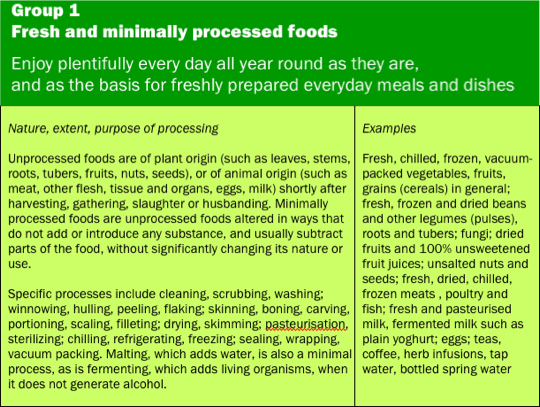
Box 2
Agricultural methods
Our classification does not identify methods of plant or animal breeding (including feeding), as processing. It is true that plant breeding and selection, such as that which has sharply reduced the number of types and strains of grain (cereals) commonly harvested and consumed, has had a profound effect on the nature of food systems. Intensive 'factory' or 'battery' farming of animals, poultry and fish, with the use of feed that is itself ultra-processed, increases their fat and degrades their fatty acid composition. There are also the vexed issues of animal welfare, of the use, overuse and abuse of biocides, and of contentious genetic modification. Further, the meat and other products of free-range animals and poultry, and of wild animals and fish, are nutritionally superior, and taste better (29,30).
After discussion, we feel that our primary responsibility is to make a broad simple classification capable of generating recommendations for generally accessible and affordable foods. We agree that 'unprocessed' and 'minimally processed' can be defined in different ways. But we feel sure that a considerably more elaborate system of classification, within which relatively fine distinctions were made, would have diminished value and use. We have no intention to discourage those that wish to make such distinctions, for example by giving less value to foods produced by intensive methods of agriculture. Points like this, concerning distinctions within our three groupings, will be made in due course in a more detailed guide.
Group 2 Culinary ingredients

Group 2 culinary ingredients include plant oils; animal fats such as butter and lard; sugar; salt; starches and flours, and uncooked 'raw' pastas made from flour and water
Culinary ingredients are essentially constituents of foods, such as plant oils; animal fats such as butter and lard; sugar; starches, flours, or else obtained from nature, such as salt.
These ingredients are often very durable. While some can be produced by hand with simple tools, most require heavy machinery. The methods that produce them, also mostly ancient in origin, have become very much more efficient and widespread as an aspect of industrialisation.
Processes include pressing, milling, crushing, grinding, pulverising, 'refining', and some of the methods used for minimal processing. Stabilising or 'purifying' agents and other additives may also be used
In isolation, they are unbalanced, being depleted in some or most nutrients. Other than salt, they typically supply 400 or 900 kilocalories per 100 grams. This is around 3-6 times more than cooked grains and around 10-20 times more than cooked vegetables.
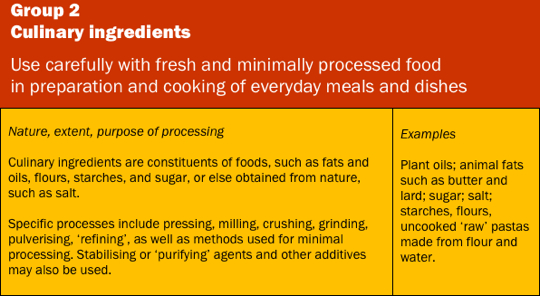
Preparation and enjoyment of meals

Group 1 foods and group 2 culinary ingredients are combined in the preparation and cooking of everyday meals and dishes, conventionally enjoyed by a family or other convivial group round a table. Adequately combined, foods and culinary ingredients can provide all essential nutrients, with an overall energy density much lower than that of ultra-processed products. Combinations of foods and culinary ingredients are the bases of classic traditional cuisines throughout history, all over the world.
A crucial point here though, is that culinary ingredients are not edible, or else normally are not consumed by themselves. Their function is to be combined with foods to make palatable, diverse, nourishing and enjoyable meals and dishes. Thus, oils are used in the cooking of cereals (grains), vegetables and pulses (legumes), and meat, and are added to salads. Flours are made into pastry used as a covering for meat or vegetable dishes or as a basis for cakes. Table sugar is used to prepare fruit- or milk-based desserts. Their nutritional significance should therefore not be assessed in isolation but in combination with foods. (Also see Box 3).
Culinary ingredients are usually cheap, and can be over-used. When used carefully they result in meals and dishes that are nutritionally balanced, with an energy density much lower than the average energy density of ready-to-consume food products, an account of which now follows.
Box 3
Basis for great food cultures
Combinations of different types of foods and culinary ingredients suited to regional, national or local climate and terrain, have been and often still remain the basis of traditional and long-established dietary patterns. Original food systems developed over long periods of time, have generated food cultures that sustained populations, and still do. As a result of experiment and trial and error, the resulting dietary patterns, when adequate and varied, are usually balanced and healthy, although some traditional methods of preservation, such as salting, are undesirable when commonly used. Overweight and obesity, and diet-related chronic non-communicable diseases, are uncommon or rare in societies whose food systems and dietary patterns are traditional or long-established (31).
The world's great cuisines usually have their basis in cultures that respect and even venerate the natural and cultivated sources of foods and the ingredients derived from foods. Long-established and evolved food cultures, often mingling the customs of different peoples and cultures, are part of the tradition, history and identity of many parts of the world, such as the Mediterranean region, Mexico and Mesoamerica, the Andean region, various Indian states, China, Japan and Thailand (30, 32-36).
Group 3 Food products
Food products are processed, or ultra-processed, and include alcoholic drinks.
These are foods altered in ways that add or introduce substances that substantially change their nature or use (processed food products); or are processed using methods that create alcohol (alcoholic drinks); or are formulations made mainly from industrial ingredients, usually containing little or no whole foods (ultra-processed products).
They are very durable products. They are edible, drinkable and palatable by themselves, and are made ready-to-consume or ready-to-heat.(Also see Box 4).
Box 4
Processing: what's good and what's bad
Adapted from (9). We are not 'against processing', any more than we are 'anti- industry' (see Box 1). We trust this is obvious from a reading of this and other papers and commentaries (such as 6-9, 11,14,16,17). Practically all food and drink is processed in some sense. Minimal methods of preservation, whether traditional such as drying, or modern such as refrigeration, protect food and make it available all year round. Food processing, in any general sense, is not a public health problem. Minimal processing is beneficial to public health, as are well-prepared meals that combine a varied balance of foods with processed culinary ingredients.
Indeed, we reject statements and claims that are, or can be seen to be, critical of food processing as such. Such positions are practically meaningless, and if taken seriously would be damaging. Many foodstuffs as found in nature are unpalatable or inedible unless subjected to some process. All perishable foods, unless consumed promptly, need to be preserved in some way. These are points rightly made by food industry representatives.
The problem with processing
The problem is not processing as such. It is the nature, extent, and purpose of processing. In particular, it is the proportion of food systems and supplies and thus dietary patterns and personal diets that are in the form of processed food products, alcoholic drinks, and most of all of ultra-processed products.
We do not state or suggest that it is best never to consume ultra-processed products. These, which typically are ready-to-consume 'fast' or 'convenience' dishes, drinks, and snacks, are not some sort of poison. It is however true that some contain toxic substances, such as alcohol and trans-fatty acids (10,14, 25).
Nor do we say or imply that the only healthy diets are those consisting solely or predominantly of fresh foods. Nobody is going to suffer as a result of occasional consumption of say French fries (chips), chips (crisps), candy (confectionery), pastries, cookies (biscuits), sugared soft drinks, uncontaminated burgers, or packaged pizzas; and bread, even in typically cheapened degraded forms, is relatively innocuous. It is however true that many ultra-processed products are formulated to be ultra-palatable and even in effect addictive (37,38).
In any country or region, the public health problem caused by ultra-processing becomes evident and then an acute crisis, as the proportion of ultra-processed products within food systems, food supplies and diets rises, as it rapidly has throughout the world especially since the 1980s. Ultra-processed products now are becoming, or in some countries already are, dominant within industrialised food systems. They therefore need to be clearly defined and separately classified, as is done here. We are also sure that what is now pandemic obesity and related chronic non-communicable diseases will be prevented and controlled when, and only when, ultra-processed products are subject to statutory regulation (25).
Processed food products

Group 3 food products include canned or bottled whole vegetables and legumes (pulses) preserved in brine; whole fruits preserved in syrup; tinned fish preserved in oil; some types of processed meat and fish such as ham, bacon, pastrami, smoked fish; and cheese, to which salt is added.
Processed food products are manufactured by adding substances such as oil, sugar or salt to whole foods, as well as using processes that also make them durable and more palatable and attractive.
The resulting products are directly derived from foods, and are still recognisable as versions of the original foods. They are generally produced to be consumed as part of meals or dishes, and also may be consumed by themselves as snacks. Most are highly palatable.
These products include canned or bottled vegetables or legumes (pulses) preserved in brine; whole fruits preserved in syrup; tinned fish preserved in oil; some types of processed meat and fish such as ham, bacon, pastrami, and smoked fish; and cheese, to which salt is added.
As with culinary ingredients, some methods used to make processed food products are originally ancient, and can be and are still used domestically or artisanally. But now almost all are industrial products. Processes include canning and bottling using oils, sugars, salt; and methods of preservation such as salting, salt-pickling, smoking, curing. The ingredients infiltrate the foods. The processes alter their nature.
Processed food products usually retain the basic identity and most constituents of the original food, but the methods of processing used make them nutritionally unbalanced, because of the addition of oil, sugar or salt. Except for canned vegetables, their energy density ranges from moderate (around 150-250 kilocalories per 100 grams for most processed meats), to high (around 300-400 kilocalories per 100 grams for most cheeses).
Alcoholic drinks

Group 3 alcoholic drinks include beer, wine, and liquor (spirits)
Alcoholic drinks are produced by methods that transform the foods and food constituents from which they are made, with the effect that alcohol is generated. The processes create liquids with different amounts of alcoholic content. They may be consumed with meals, or socially, or on other occasions. They are made to be enjoyable.
Alcoholic drinks include beer, wine and spirits, derived from grains (cereals), fruits, vegetables, roots, or tubers.
As with processed culinary ingredients and many processed food products, most methods used to make alcoholic drinks are originally ancient, and can be and are still used domestically or artisanally. But again, now almost all are industrial products. Processes include malting, brewing, fermenting, distilling, filtering.
Alcoholic drinks contain few or practically no nutrients. Alcohol is potentially addictive, and therefore alcoholic drinks are liable to be consumed excessively and to displace meals and foods. Alcohol is toxic. (See Box 5).
Box 5
Big Alcohol

Big Alcohol advertising. Public health advocates would ban such advertisements and instead require warnings that alcohol causes incontinence and impotence
Largely taken from (25, 39-43). 'Big Alcohol' refers to huge corporations that manufacture, distribute and sell alcoholic drinks. Now operating as lightly regulated transnational businesses, they have deeply penetrated markets most of all in the global South, in Asia, Africa and Latin America. The term 'Big Alcohol' is used by analogy with 'Big Tobacco' and 'Big Pharma', which refer respectively to the transnational and other very large corporations whose profits depend on cigarettes and other tobacco products, and on drugs and similar products.
The average level of consumption of alcoholic drinks has not changed much in this century. But with alcohol, global figures are not very useful. Almost half of all men and two-thirds of all women do not drink alcohol.
Alcohol control regulation works
In many countries and states within countries, alcohol is identified as a drug, or an antisocial, dangerous and addictive substance, and as such is made subject to various laws, including taxation, prohibition of underage purchase, and restrictions on sale. Alcohol consumption in France has on average almost halved since the 1960s, as a result of restrictions that include a total ban of television advertising, a ban on any advertising that shows people drinking, strict limits on maximum permissible levels of blood alcohol when driving, and an obligation that all motorists carry a breathalyser in their cars.
However, in most countries alcoholic drink manufacturers enjoy a more or less 'free market'. The 'neo-liberal' political and economic ideology which remains dominant, as from the 1980s has created a new type of laissez-faire capitalism now practiced by what have become colossal transnational corporations. Their success is based on aggressively marketed branded products using advertisements that often associate unhealthy – or in the case of alcohol, toxic – products with successful, alluring, glamorous ways of life (15). See the pictures above, for liquor, a pre-mix cocktail, and beer. The middle picture shows a bottle shaped like a perfume container. An acute public health problem caused by alcohol is 'binge' or explosive drinking by adolescents and young adults, including women. Overuse and abuse of alcohol is the leading cause of death among males between 15 and 59 (39).
AB InBev, the transnational conglomerate that owns Budweiser (shown in the right-hand picture) reported in 2012 annual profits of $US 5.8 billion, on sales of $US 39 billion. The corporation has taken over big national companies in China, Mexico, Brazil and elsewhere. Diageo owns José Cuervo tequila (left in the pictures above). Annual profits reported in 2012 were just under $US 5 billion, on sales of $US 23.5 billion. Chief executive Paul Walsh stated 'We have seen very attractive growth in Asia, Latin America, and Africa' with sales rising at a rate of 15 per cent a year (44).
Ultra-processed products

Group 3 ultra-processed products that are now produced and consumed in vast quantity all over the world include breakfast cereals, cake mixes, 'energy' bars; 'instant' packaged soups and noodles; many types of sweetened breads and buns, cakes, pastries and desserts; chips (crisps), and very many other types of sweet, fatty or salty snack products; sugared milk and fruit drinks, and soft cola and 'energy' drinks. Ultra-processed ready-to-heat products include pre-prepared meat, fish, vegetable or cheese dishes, pizza and pasta dishes, burgers and hot dogs, and French fries (chips), and poultry and fish 'nuggets' or 'sticks' ('fingers'). They also include bread and other cereal products made with wheat flour, water, salt and other ingredients; animal products made from flour and salt with scraps or remnants of meat; and cookies (biscuits), preserves (jams); sauces, meat, yeast and other extracts; ice-cream, chocolates, candies (confectionery); margarines; canned or dehydrated soups; and infant formulas, follow-on milks and baby products.
Ultra-processed products are formulated mostly or entirely from industrial ingredients, and typically contain little or no whole foods.
The purpose of ultra-processing is to devise products that are durable, convenient, highly or hyper-palatable, and profitable. These products typically are not recognisable as versions of foods, although ultra-processing includes techniques designed to imitate the appearance, shape and sensory qualities of the foods processed to obtain the ingredients. Most are designed to be consumed by themselves or in combination as snacks or drinks.
Most of the ingredients used by food manufacturers to make ultra-processed products are not available in supermarkets or other retail outlets, and are not used in the culinary preparation of dishes and meals in kitchens. While some are directly derived from foods, such as oils, fats, flours, starches, and sugar, others are obtained by the further processing of food constituents, by for example hydrogenation of oils (which can generate toxic trans-fats), hydrolysis of proteins, and 'modification' of starches. Numerically, the great majority of the ingredients of ultra-processed products are additives of a variety of types, which include preservatives; stabilisers, emulsifiers, solvents, binders, bulkers; sweeteners, sensory enhancers, flavours, and colours. Bulk may come from air or water. Synthetic micronutrients may be added to 'fortify' the products.
Wholly industrial technology includes the hydrogenation and hydrolysis processes, as well as the techniques designed to make ingredients appear to be foods or else to invent novelty products, such as extruding, moulding, and reshaping. They also include industrial versions of cooking such as pre-processing by frying and baking. Such methods simulate domestic cooking but are typically very different, involving a number of or many processes and processing aids.
Some techniques used to make ultra-processed products are originally ancient or old. But most ultra-processed products now are inventions of increasingly sophisticated food science and technology, as this has developed during and after industrialisation. Newer versions of these products are usually initially formulated in industrial laboratories.
The first ultra-processed products included bread and other cereal products made from wheat flour, water, and salt; and animal products made from flour and salt, with scraps or remnants of meat. These originally used a small number of ingredients.
Ultra-processed products created as part of industrialisation, some of which have been commonly consumed for generations, include cookies (biscuits), preserves (jams); sauces, meat, yeast and other extracts; ice-cream, chocolates, candies (confectionery); margarines; canned or dehydrated soups; and infant formulas, follow-on milk and baby products.
Other products originally formulated and branded some time ago, now very commonly consumed, include many sold ready-to-eat, some with the addition of liquids, or ready-to-drink. Examples are breakfast cereals, cake mixes, 'energy' bars; 'instant' packaged soups and noodles; many types of sweetened breads and buns, cakes, pastries and desserts; chips (crisps), and very many other types of fatty, sweet or salty snack products, sugared milk and fruit drinks, and soft cola and 'energy' drinks.
Ultra-processed ready-to-heat products are now very commonly consumed either at home or at fast food outlets. These include pre-prepared meat, fish, vegetable or cheese dishes; pizza and pasta dishes; burgers and hot dogs; French fries (chips); and poultry and fish 'nuggets' or 'sticks' ('fingers'). They often appear to be much the same as home-cooked meals or dishes; but they are not. They typically are also ultra-processed, because of the nature of much or most of what they contain, and because of the combinations of preservatives and other additives used in their formulation. (See Box 6).
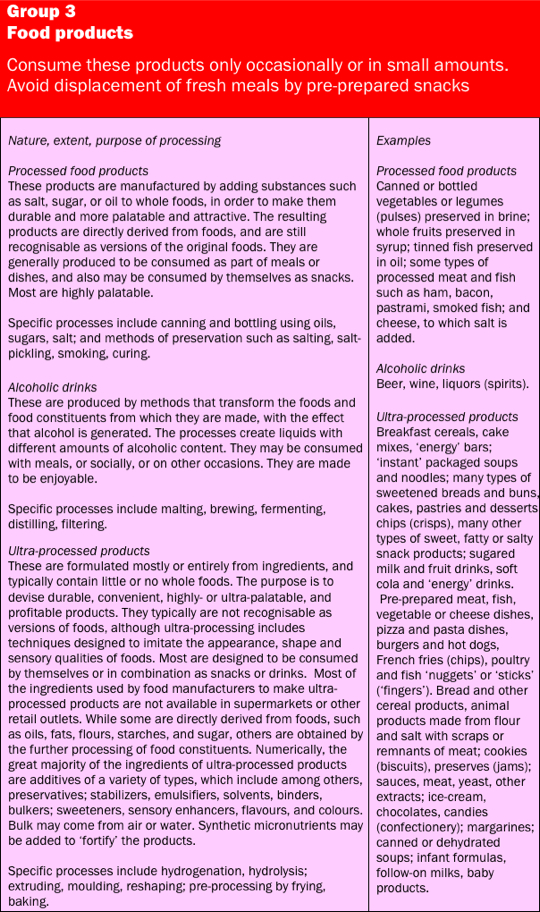
Box 6
Big Food and Big Snack

Big Food and Big Snack advertising. Much of it is aimed at children and young people, designed to build life-long loyalty to branded ultra-processed products
Adapted from (9) and also taken from (10, 13-18, 23-25, 37, 38, 41). 'Big Food' refers to transnational food and drink product manufacturing corporations, that collectively – together with Big Alcohol – now dominate the global food system. An alternative term is 'Big Snack', for most of their products are made to be ready-to-consume, almost anywhere (23). These corporations include Kellogg's, McDonald's and PepsiCo, owners of the brands advertised above. The Pepsi 'Live for Now' campaign launched earlier this year, is global (46). They also include Kraft, General Mills, Coca-Cola, Nestlé. Mars, Unilever, and Yum! Brands .
Economic globalisation and its consequences
As from the 1980s, as a central aspect of economic globalisation, very large companies became transnational corporations able to operate with unprecedented commercial freedom (45). World trade laws enable them to mount appeals against decisions designed to protect public health made by national courts of law (47).
The growth of the transnationals, which by their nature have no national allegiance, and which are free to buy materials, land, machinery and labour in cheap markets, has occurred with phenomenal speed and force. The combined annual sales of the ten corporations mentioned above were, as recorded in 2012, around $US 400 billion. This is roughly equivalent to the annual gross domestic product of countries such as Austria and South Africa. If the sales of the three leading Big Alcohol corporations, AB InBev, Diageo, and SAB Miller are included, the total figure is well over $US 500 billion, about the same as the gross domestic product of Switzerland. Annual profits of the 13 corporations combined, as reported in 2012, were over $US 60 billion. The annual advertising and marketing spend of two corporations, Coca-Cola and PepsiCo, is reckoned in 2012 to be around $US 6 billion.
While transnationals with similar products are competitive with one another, they also 'hunt as a pack'. They form representative bodies designed to protect their common interests, which include resistance to statutory regulation, and the formation of 'public-private partnerships' with international agencies and national governments in which they are the private 'partners'. Such bodies are now recognised within the United Nations system as civil society organisations (49)
The problem with industry
Further, the Big Food and Snack corporations are all, seen through the lens of this and associated commentaries and papers, in the same business. Their sales, profits, and share price depend on the manufacture and sale of intrinsically unhealthy products, some of which contain toxic trans fats, and many of which are hyper-palatable and habit-forming. Alcohol is both toxic and addictive.
In Box 1, above, we stated that we are not critical of industry as a whole, not of the food industry as a whole, We are however sharply critical of the transnational and other very large corporations whose profits depend on ultra-processed products and alcoholic drinks. We are also sharply critical of the still prevailing 'free market' political and economic ideology espoused by international agencies and national governments, that has created monstrous corporations whose products, taken together, are demonstrably damaging to public health and also public goods.
The impact of the food and drink product corporations is obvious but often not currently blatant in high-income countries of the global North whose food supplies are already saturated and flooded with ultra-processed products. In the global South the impact is blatant. Big Food and Big Snack are aiming for and achieving 'double-digit growth', meaning sales increasing by 10 per cent or more every year. In this way transnational corporations are rapidly displacing traditional and long established food systems and dietary patterns.
Saving the world and making more profit
Thus, Nestlé has established what it calls 'popularly positioned products', aimed at the 3 billion people with the lowest incomes, also known as 'emerging consumers' (50). The products are mostly existing Nestlé branded lines in smaller packages or in sachets, such as soup cubes, instant coffee and drinks, ice-creams, cookies (biscuits), and weaning products. By weight the prices can be more expensive. Annual sales amounted to roughly $US 5.5 billion in 2012, increasing by over 25 per cent a year. People recruited from local communities by external agents are trained to sell the products and to act as 'nutrition advisors'.(18, 24, 40).
Problems with ultra-processed products

The general impact of ultra-processed products amounts to a public health catastrophe. One reason is that they are consumed any time, everywhere
A number of nutritional, metabolic, social, economic and environmental characteristics of ultra-processed products are problematic.
1 Nutritionally unbalanced
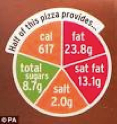
They are nutritionally unbalanced, as are processed food products. They are characteristically fatty, sugary or salty, or depleted in dietary fibre and various micronutrients and other bioactive compounds. They are often high in saturated fats or trans-fats. Further, the safety of various specific additives, and classes or combinations of additive used in their formulation, is unknown or disputed.
2 Energy-dense

Due to their main ingredients and the lack of fibre and water, when solid their energy density ranges from fairly high (around 225-275 kilocalories per 100 grams for bread), to high (around 350-400 kilocalories per 100 grams for 'energy' bars) to very high (400-500 kilocalories per 100 grams for most biscuits and also chips (crisps) ).
3 Hyper-palatable

Their ingredients and formulation make all of them hyper-palatable and some habit-forming and even quasi-addictive. They typically have high glycaemic loads. They are therefore liable to derange the endogenous processes in the digestive system and brain that signal satiety and control appetite, and to cause passive energy over-consumption.
4 Displace meals

They are very easy to consume. They are usually in the form of snacks, drinks, desserts or ready-to-consume dishes. Meal tables, and often plates and implements, are not needed. They therefore displace foods, and dishes and meals prepared from foods at home, or outside the home in places where food is prepared on the spot. Typically they are designed to be consumed anywhere – in catering outlets, from drive-ins and takeaways, at home while watching television, at a desk or elsewhere at work, or in the street. This is why they are often termed 'fast' or 'convenient'.
5 Imitations of food
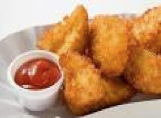
Many are formulated or promoted in ways that are misleading. They imitate food, for example by being molded and extruded into food-like shapes, or by the use of cosmetic and other additives which may be intrinsically innocuous but which give a false impression of food, usually in a more intense form. Often the only food present is in pictures on the product label or in other forms of advertising. These are additional reasons why they displace foods and meals.
6 Falsely seen as healthy

Many create a false impression of being healthy, by the addition of synthetic vitamins, minerals and other compounds, as a result of which the manufacturers are allowed to make prominent health claims, despite the product remaining unhealthy.
7 Aggressively advertised

Most are extremely profitable, being branded products of transnational and other very big corporations able to buy or make processed industrial ingredients very cheaply, and that operate economies of scale. The biggest corporations spend vast amounts of money on advertising and promotion, including cross-advertising between brands, to make their products attractive and even glamorous, especially to vulnerable consumers such as children and young people.
Trends
Our epidemiological work on trends in consumption especially of ultra-processed products is currently at an early stage. Here are some preliminary observations. We invite comments.
Foods, ingredients, and meals
Meals made with foods and ingredients are being displaced by ultra-processed products, usually formulated to be ready-to-consume as snacks, at different times and rates, in different parts of the world. The rates of displacement are, and as stated by the industries responsible, much faster in the global South.
Processed food products
These food products first became mass manufactured and thus much more available and affordable as a central aspect of industrialisation (51). Canned, salted, cured and otherwise processed products became standard household items in most countries early last century. Taken together, evidence so far suggests that overall consumption of processed food products is generally not high, and is not changing much.
Alcoholic drinks
Average rates of consumption of alcoholic drinks, and rates of over-consumption, alcoholism, and diseases caused by alcohol, vary greatly between and within countries and regions. It is well established that the main linked factors affecting rates of consumption of alcoholic drinks at population level are access and price, which is to say, the degree of taxation, restriction, and other regulation. Where regulation is light, including in countries in the global South, sales to and consumption notably by young people and women is increasing fast.
Ultra-processed products
Ultra-processed products, like processed food products, became mass manufactured, cheaper, more available and thus more consumed, again at first as part of the process of industrialisation (51). Examples of products commonly consumed in industrialised countries as from the 19th century and early last century included baby formula, breakfast cereals, cookies (biscuits), cakes and confectionery, other fatty or sugary products, mass-manufactured breads, margarines, and soft drinks. Initial reading of relevant literature suggests that consumption of most of these products, with exceptions such as cheap bread and margarine (and baby formula in the case of infants) was usually not high anywhere until well into the second half of the last century.
We propose that three linked developments have resulted in accelerated production and consumption of ultra-processed products, and consequent sharp rises in overweight, obesity, and related diseases. One is rapidly increased sophistication of food technology, which has made ultra-processed products cheaper to make, often intensely palatable, and very profitable. Two is the general trend against traditional ways of life and towards seeking immediate individual gratification. Three (see Boxes 5 and 6) is economic globalisation and thus the creation of colossal lightly regulated transnational corporations with vast advertising and marketing budgets, that continue aggressively to penetrate countries notably in the global South.
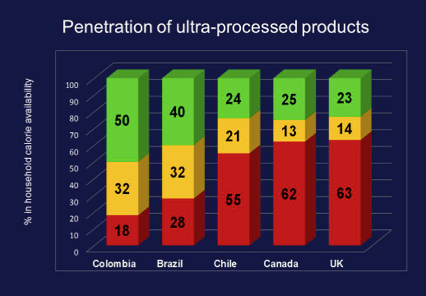
The relative contribution of foods, culinary ingredients and of processed and ultra-processed products, to the food supplies of five countries (52)
Initial research conducted so far (20-22) and work now in progress (such as 52) indicates that in the last half-century and in particular since the 1980s, the contribution of processed and ultra-processed products to food supplies as a proportion of dietary energy in high-income countries has risen from around 30 to 50 per cent or more. The figure above shows that consumption of processed and ultra-processed products (shown in brown) rises as a percentage of total energy intake as average incomes and thus market opportunities rise, with five countries, Colombia, Brazil, Chile, Canada and the UK, as examples. Correspondingly, consumption of unprocessed and minimally processed foods (shown in green) and of culinary ingredients (shown in yellow) used with foods to make meals, falls
Within the phenomenal rise in production and consumption most of all of ultra-processed products, the main increase has been in branded products formulated or reformulated in recent times. In recent decades the relative increase in many lower-income countries has been faster, from around 15 to 30 per cent or more, and is projected to rise to the same levels as in high-income countries. These rises are paralleled by rises in the rates of obesity and of related chronic non-communicable diseases.
The scope and nature of evidence
As stated, this commentary is proposing a general theory, in the dictionary sense of 'a system of ideas or statements explaining something'. As such, it remains work in progress. It is consistent with common sense and everyday observation, and with evidence normally not admitted as 'science', such as 'Euromonitor' analyses made by and on behalf of the financial markets and industry (53). The theory fits with the relevant facts and evidence that are known to us and to colleagues also cited here. It is also consistent with the narratives of independent expert reports such as those produced by relevant United Nations agencies (2,3) and authoritative national bodies. It has explanatory power and is eminently testable.
We are also now confident that other systems of ideas and statements now used in the field we are working in, do not fit well with the facts, do not have adequate explanatory power, and evidently are not leading to policies and actions that work.
Our theory is new
What is proposed here is new, and therefore is not and cannot yet be consensual. Our conclusions do not directly derive from studies whose results are now generally identified as 'strong' or 'hard' scientific evidence. Such studies, and in particular randomised controlled trials (RCTs) whose conclusions are made more powerful by meta-analyses and systematic reviews, have not been undertaken. At this stage that cannot be. In any case, RCTs in the field of nutrition and health currently depend on a system of classification of food – itself dependent on the concept that foods should be grouped roughly according to their relative content of chemical macro- and micro-constituents – which still almost completely ignores or at best marginalises the significance of food processing.
We are now beginning to test the theory by initial epidemiological investigation of trends in patterns of consumption and patterns of overweight, obesity and associated diseases, in various countries. This work requires examination of food expenditure and food consumption surveys capable of being analysed in terms of our new classification.
Why processing is overlooked
If processing, and types of processing, are so important, why has this been overlooked? There are a number of reasons. One is that food technology is not a significant part of the nutrition science curriculum. Another is that nutrition scientists continue to depend on a conceptual framework of their discipline elaborated from the discoveries of biochemists between the early 19th and early 20th century, which has diminishing relevance.
Another reason is that any approach to nutrition and human health that gives special attention to food processing, is a 'hot topic'. In these days of 'public-private partnerships', much food and nutrition policy is a result of collaboration between international and national civil servants, their scientific advisors, and senior scientists, together with representatives of the transnational and other big food and drink manufacturers whose profits depend on ultra-processed products and that are thus in direct conflict with the interests of public health. This continues to impede progress (23-25, 41).
The scope of nutrition science
Perhaps the greatest obstacle to seeing the significance of food processing in all its aspects, is the identification of nutrition as solely or mainly a biological discipline, a branch of biochemistry heavily influenced by the clinical 'medical model'. By contrast, we are impressed by the work of some lay writers (53-55). In our own work we have learned much from such authors. To the best of our knowledge, our classification is the first to be published in the specialist literature that makes sense of modern food systems in the context of nutrition, disease, health and well-being. We have been encouraged in this belief by comments, some critical, always constructive, and support from many colleagues.
The significance and impact in particular of ultra-processing on human health, can be seen only with a 'big picture' vision, which identifies nutrition – or at least public health nutrition – as also a social, economic and environmental discipline (55).
The nature of evidence
Much depends on what is counted as evidence, in the dictionary sense of 'facts in support of a conclusion, statement or belief'. Thus, findings from the so-called 'soft' social sciences now also need to be admitted, as a necessary contribution to any soundly based conclusions and recommendations on nutrition and human health.
Wise conclusions are not mechanical. They require common sense and considered judgement. Moreover, there are occasions in public life that are so urgent, important and critical, that action must be taken before all the evidence is in. The impact of the action can then be examined and monitored, and if necessary the action revised. The pandemic of obesity, in particular among children and young people, is such a case.
Summary
Food processing, most of all in relatively new forms, is now the main force shaping the global food system, and is the main determinant of dietary patterns.
Our work undertaken for some years (4,5), and regularly published and accepted since 2009 (6-11, 13-25), consistently indicates that the phenomenal worldwide rise in the production and consumption of what are identified and defined here as ultra-processed products, typically in the form of snacks, 'fast foods', and soft drinks, have displaced and are displacing dietary patterns mostly based on meals, throughout the world (23-25, 41).
This we believe is profoundly significant. The phenomenal and very rapid shift in food systems and supplies, notably since the 1980s, is paralleled by a vast rise in rates of obesity and related chronic non-communicable diseases in the same time period. So far the evidence all points in the same direction towards one judgement, which is that the relationship between the changes in dietary patterns and disease patterns is causal. That is to say, the transformation of the global food system is what above all is driving what is now pandemic obesity and rapid rises in related diseases. This thesis has profound global policy implications
Our work so far is taking two forms. First, as shown in the previous pages, we have created a new classification in which all substances that may be consumed and that contain nutrients, are divided into foods, culinary ingredients, and food products.
Second, in partnership with co-workers in an increasing number of countries, we are analysing national dietary surveys and thus trends in consumption of ready-to-consume (group 3) food and drink products, together with indicators of the quality of diets and the frequency of obesity and chronic non-communicable diseases.
How to use the classification
In epidemiological analyses, the new classification can be applied to information collected by the use of household food purchase surveys, and also by individual food consumption surveys.
The household purchase of foods is readily classified into one of the three groups in the classification. When this includes meals and dishes freshly prepared in restaurants, the classification is made by separating out the foods, ingredients and food products used in preparation and cooking.
The same applies to information from individual food consumption surveys, except that the separating out of meals and dishes into foods, ingredients and food products will be more frequent, because food consumption surveys will include all meals and dishes prepared and cooked at home.
We invite colleagues in other research centres to work with us.
Purposeful guidelines
A prime purpose of our food classification, which we believe reflects the realities of this century, is to be the basis for population goals and personal dietary guidelines designed to promote health and well-being and protect against disease.
Such recommendations will be vitally different from those so far issued, which are usually based on nutrients and nutrient-based food groups. Thus, recommendations to consume culinary ingredients moderately, is conceptually different from warnings against such ingredients as energy-dense, because as stated, they are not consumed alone, but in combination with food in the form of meals and dishes. Indeed, few current dietary guidelines make any mention of meals, and are consistent with the mistaken notion that diets dominated by ultra-processed products can have the same health value as diets based on meals made with foods and culinary ingredients.
While by their nature processed products are unhealthy, we are not suggesting that they are all best avoided. Not at all. When consumed occasionally and usually in small amounts, they are normally harmless. Products using wheat flour such as bread are obvious examples, as are many products consumed as delicacies or treats or as part of occasional feasts. It is when they make up a large part or most of food supplies, dietary patterns and diets, and when any of them is consumed constantly in large quantities, that they are harmful. (And see Box 4).
Rational policies and effective actions
Prevention and control of obesity and related chronic non-communicable diseases requires control and restriction of the products that, consumed in current quantity, cause these conditions.
We see the issue of ultra-processed products as being much the same as that now well understood with alcoholic drinks. They are designed and promoted to be highly or hyper-attractive. They are liable to be consumed excessively. They are nutritionally unbalanced. Many are habit-forming and have addictive qualities. Some contain toxic substances. For all these reasons they require statutory regulation and control (9,10,15,16,18,23-25,37,38,41).
In all countries, policies need to be designed to check and reduce the volume in particular of ultra-processed products in food systems and supplies. These products need to be identified, isolated and categorised as such, their contribution to population energy consumption quantified, and their supply regulated. Processed products and alcoholic drinks, when consumed, also need to be eaten or drunk in small amounts.
The 'market' system that has led to the current explosion of processed products may well be seen as part of an overall failure. In these circumstances, the protection of public health and public goods has over-riding importance.
Conclusion
Ultra-processing, carried out on its present and projected scale, amounts to a vast global experiment undertaken without attention to its nature or consequences. Indeed, our classification is the first to identify and account for ultra-processed products as such.
Obesity with all its implications is out of control. It is a global crisis projected to be a catastrophe. With the most relevant classification of food as an essential tool, United Nations agencies and other international organisations, together with national governments at head of state level, need to combine with other actors to protect, support and develop healthy food systems and supplies. These will not be untested inventions. They correspond to traditional and long-established sustainable and appropriate methods of agriculture, horticulture and manufacture that remain in place, though threatened, in many countries.
The significance and impact of ultra-processed products can be fully understood only in a broad economic and political context. Dominant policies of privatisation, deregulation and globalisation of world food systems have concentrated food manufacture, distribution and supply into the hands of a relatively small number of gigantic transnational corporations, some individually with annual sales the size of the gross national products of medium-size countries. Dietary patterns and diets in most countries, now and in the near future, are or are liable to be largely determined by these transnational corporations. Manufacturers use their products as ways in which to penetrate 'emerging markets' in the global South, and also to increase their control of the global food system.
We believe that interventions designed in the public interest, which at least initially may be opposed by commercial interests, will be, when properly presented, generally popular. The control and eventual prevention of obesity will include a more diverse food industry, more rural employment, and better educated children, as well as appreciation and development of the world's great cuisines, themselves a source of employment and wealth.
Processed food products, and in particular alcoholic drinks and ultra-processed products, also have other profound social (including cultural), economic, political and environmental impacts. These will be elaborated in a later commentary.
Last word
Classifications of foods and food products are an essential basis for dietary recommendations. As such they are a necessary foundation for public policies and actions designed to enhance well-being, to protect health, and particularly to prevent and control obesity and diet-related diseases at any level, from local to global.
To this end, a method of food classification that recognises the significance of different types of food processing is essential. We believe our classification is a sound basis for the work needed to protect and improve food, nutrition and public health in all societies and circumstances worldwide
References
- Cannon G. The rise and fall of dietetics and of nutrition science 4000 -2000 CE. Public Health Nutrition 2005, 8, 6A: 701-705.
- World Health Organization. Diet, Nutrition and the Prevention of Chronic Diseases. Report 797. Geneva: WHO, 1990.
- World Health Organization, Diet, Nutrition and the Prevention of Chronic Diseases. Report 916. Geneva: WHO, 2003
- Monteiro CA, Mondini L, Levy-Costa RB (2000). Secular changes in dietary patterns in the metropolitan areas of Brazil (1988-1996). Revista de Saúde Pública 34: 251-258.
- Levy-Costa RB, Sichieri R , Pontes NS, Monteiro CA (2005) Household food availability in Brazil: distribution and trends (1974-2003). Revista de Saúde Pública 39: 530-540.
- Monteiro CA (2009) Nutrition and health. The issue is not food, nor nutrients, so much as processing [Commentary]. Public Health Nutrition 12: 729-731.
- Monteiro CA, Levy RB, Claro RM, Castro IRR, Cannon G (2010). A new classification of foods based on the extent and purpose of food processing. Cadernos de Saúde Pública 26: 2039-2049.
- Anon. Nutrition science: Time to start again. [Editorial] World Nutrition, November 2010, 1, 6: 230-236. Obtainable at www.wphna.org.
- Monteiro C. The big issue is ultra-processing.[Commentary] World Nutrition, November 2010, 1, 6: 237-269. Obtainable at www.wphna.org.
- Monteiro C. The big issue is ultra-processing. The hydrogenation bomb. [Commentary] World Nutrition, April 2011, 2, 4: 176-194. Obtainable at www.wphna.org
- Monteiro C. The big issue is ultra-processing. In praise of the shared meal. [Commentary] World Nutrition, May 2011, 2, 5: 235-246. Obtainable at www.wphna.org.
- Schuftan C. Food price crises: 'Free markets' cause inequity and hunger. [Commentary] World Nutrition, June 2011, 2, 6: 254-270.
- Monteiro C. The big issue is ultra-processing. There is no such thing as a healthy ultra-processed product. [Commentary] World Nutrition, August 2011, 2, 7: 333-349. Obtainable at www.wphna.org.
- Monteiro C. The big issue is ultra-processing. The good, the bad, and the toxic. [Commentary] World Nutrition, October 2011, 2, 9:496-507. Obtainable at www.wphna.org
- Moubarac J-C. The big issue is ultra-processing. Sexing up ultra-processed products. [Commentary] World Nutrition, March 2012, 3, 3: 62-80. Obtainable at www.wphna.org
- Anon. Processing. The big issue. Q: What drives global obesity? A: This is obvious. [Editorial] World Nutrition, June 2012, 3,6, 250-256. Obtainable at www.wphna.org.
- Monteiro C, Cannon G. The big issue is ultra-processing. What are ultra-processed products. [Commentary] World Nutrition, June 2012, 3, 6: 257-268. Obtainable at www.wphna.
- Monteiro CA, Cannon G. The Food System. Ultra-processed products. Product reformulation will not improve public health. [Commentary]. World Nutrition, September 2012, 3, 9, 406-434. Obtainable at www.wphna.org.
- Schmidt MI, Duncan BB, Silva GA, Menezes AM, Monteiro CA, Barreto SM, Chor D, Menezes PR (2011) Chronic non-communicable diseases in Brazil: burden and current challenges. The Lancet 377: 1949-1961.
- Monteiro CA, Levy RB, Claro RM, Castro IRR, Cannon G (2011) Increasing consumption of ultra-processed foods and likely impact on human health: evidence from Brazil. Public Health Nutrition 14: 5-13
- Levy RB, Claro RM, Mondini L, Sichieri R, Monteiro CA (2012) Regional and socioeconomic distribution of household food availability in Brazil, in 2008-2009. Revista de Saúde Pública 46: 6-15.
- Moubarac J-C, Martins AP, Claro R, Levy R, Cannon G, Monteiro CA. Consumption of ultra-processed foods and likely impact on human health. Evidence from Canada. Public Health Nutrition.. Available on CJO doi:10.1017/S1368980012005009.
- Monteiro CA, Gomes FS, Cannon G (2010) Can the food industry help tackle the growing burden of under-nutrition? The snack attack. American Journal of Public Health 100: 975-981.
- Monteiro CA, Cannon G. The impact of transnational 'Big Food' companies on the South: a view from Brazil. PLoS Medicine 9 (7): e1001252. doi:10.1371/ journal.pmed.1001252. Published 3 July 2012.
- Moodie R, Stuckler D, Monteiro C, Sheron N, Neal B, Thamarangsi T, Lincoln P, Casswell S. Profits and pandemics; preventing the harmful influence of the tobacco, alcohol and ultra-processed food and drink industries. The Lancet. Accepted for publication October 2012.
- Davis M. Late Victorian Holocausts. El Niño Famines and the Making of the Third World. London: Verso, 2001.
- Sen A. Poverty and Entitlement. An Essay on Entitlement and Deprivation. Oxford: Oxford University Press, 1981.
- Engels F. The Condition of the Working Class in England. London: Penguin, 1987. [First published in German, 1845].
- Crawford M, Marsh D. The Driving Force. Food, Evolution, and the Future. London: Heinemann, 1989.
- Tudge C. So Shall We Reap. The Concept of Enlightened Agriculture. London: Allen Lane, 2003.
- Trowell H, Burkitt D (eds). Western Diseases: Their Emergence and Prevention. London: Edward Arnold, 1981.
- Davidson A. The Penguin Companion to Food. London: Penguin, 2002.
- Toussaint-Samat M. History of Food. Oxford: Blackwell, 1992. (First published in French, 1987)
- Câmara Cascudo L. História da Alimentação no Brasil. São Paulo: Global, 2004.
- Jacoby E. The best food on earth. Peru: As good as it gets. [Commentary]. World Nutrition, July 2012, 3,7, 294-306. Obtainable at www.wphna.org.
- Jacoby E, Murillo P. The best food on earth. Peru. The union of agriculture, gastronomy, nutrition. [Commentary].World Nutrition, August 2012, 3,8, 358-372. Obtainable at www.wphna.org.
- Anon. Addiction. Food on the brain [Editorial]. World Nutrition, September 2012, 3,9, 386-391. Obtainable at www.wphna.org
- Brownell K, Gold M. Food products. Addiction. Also in the mind. [Commentary].World Nutrition, September 2012, 3,9, 392-405. Obtainable at www.wphna.org.
- World Health Organization. Global Status Report on Alcohol and Health.Geneva: WHO, 2011.
- Jernigan D. The global alcohol industry: an overview. Addiction. 2009; 104 (1): 6-12.
- Stuckler D, McKee M, Ebrahim S, Basu S. Manufacturing epidemics: the role of global producers in increased consumption of unhealthy commodities including processed foods, alcohol, and tobacco. PLoS Medicine 2012; 9(6). e1001235. doi:10.1371/journal.pmed.1001235.
- Jahiel RI. Babor TF. Industrial epidemics, public health advocacy and the alcohol industry: lessons from other fields. Addiction 2007; 102 (9): 1335-1339.
- Babor T, Caetano R, Casswell S, et al. Alcohol: No Ordinary Commodity. Oxford: Oxford University Press; 2003.
- BBC News. Guinness maker Diageo sees profits jump. 25 April 2012. http://www.bbc.co.uk/news/business-19353088
- Castells M. The Rise of the Network Society. Volume 1 of The Information Age: Economy, Society and Culture. Second edition. Oxford: Blackwell, 2000.
- Buss D. Pepsi kicks off 'Live for Now' global campaign with Nicki Minaj. Brand Channel, 30 April 2012. http://brandchannel.com/home/post/ 2012/04/30/Pepsi-Live-for-Now-Campaign-043012.aspx
- Jacoby E, Rivera J, Cordero S, Gomes F, Garnier L, Castillo C, Reyes M. Legislation. Children. Obesity. Standing up for children's rights in Latin America. [Commentary]. World Nutrition, November 2012, 3, 11, 483-515. Obtainable at www.wphna.org.
- Anon. Down from the UN NCD Summit. The right road. [Editorial] World Nutrition, October 2011, 2, 9: 458-464. Obtainable at www.wphna.org.
- Nestlé Research. Popularly positioned products. Affordable and nutritious. Vevey, Switzerland: Nestlé, 2011.
- Giedion D. Mechanization Takes Command. New York: Oxford University Press, 1948.
- Moubarac J-C. Consumption of ultra-processed products in the Americas, and impact on public health. Presentation given at the XVI congress of the Association of Latin American Nutrition Societies (SLAN), Havana, Cuba, November 2012. To be published.
- Patel R. Stuffed and Starved. From Farm to Fork. The Hidden Battle for the World Food System. London: Portobello, 2007.
- Euromonitor International. Outlook for Global Food Trade. Outlook for US Food Products Consumption and Export Trends. Euromonitor, 2010. http://fea.files.cms-plus.com/Presentations/Outlook%20for%20 Global%20Food%20Trade.pdf
- Roberts P. The End of Food. Boston: Houghton Mifflin Harcourt, 2008.
- Pollan M. In Defense of Food. An Eater's Manifesto. New York: Penguin, 2008.
- Anon. The Giessen Declaration. Public Health Nutrition 2005, 6(A): 783-786.
Acknowledgement and request
Concept and initial planning of the classification CAM GC RBL RMC. Initial drafting of the classification lists CAM RBL with input from other authors and team members. Drafting of main text CAM GC with input from the other authors. Drafting of introduction, boxed text, visual and supporting text GC with input from the other authors. Further drafts of the whole commentary approved by CAM, GC, RBL, RMC, J-CM. Final text incorporating response to reviewers and boxed and supporting text revised and approved by CAM GC. The commentary has been reviewed by Enrique Jacoby and Patricia Murillo.
Funding for this commentary: none. Conflicting or competing interests: none declared. Work on The Food System and specifically on the significance of food processing, is originated at the Centre for Epidemiological Studies in Health and Nutrition, School of Public Health, University of São Paulo. Members of the team include Ana Paula Martins, Maria Laura Louzada, Larissa Baraldi, and Daniela Canella, all of whom have undertaken research on the classification and other aspects the commentary, and have contributed to discussion.
Figures for energy density of foods, ingredients and products are taken from standard food composition tables. Figures for sales, profits and advertising and marketing spends of Big Alcohol, Big Food and Big Snack companies are taken from publicly available sources such as corporation annual reports, trade press reports, and other industry and also independent information. Checks show that wikipedia is a reliable easily accessed source of such information, as it is for rankings of national gross domestic product.
Readers may make use of the material in this commentary if acknowledgement is given to the Association, and WN is cited. Please cite as: Monteiro CA, Cannon G, Levy RB, Claro RM, Moubarac J-C . The Food System. Processing. The big issue for disease, good health, well-being. World Nutrition, December 2012, 3, 12, 527-569. Obtainable at www.wphna.org.
All contributions to World Nutrition are the responsibility of their authors. They should not be taken to be the view or policy of the World Public Health Nutrition Association (the Association) or of any of its affiliated or associated bodies, unless this is explicitly stated.






